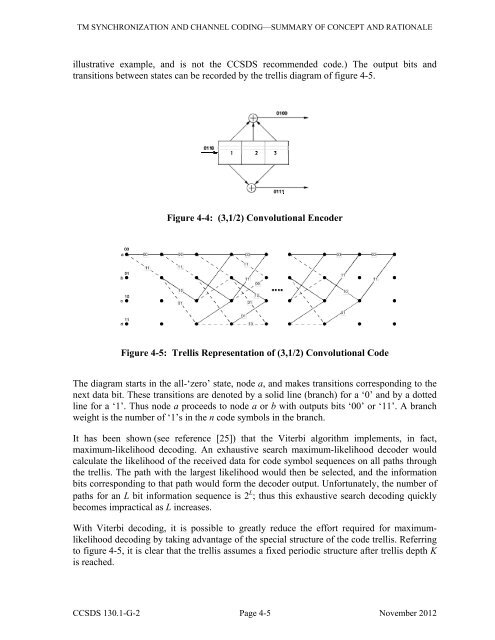TM SYNCHRONIZATION AND CHANNEL CODING—SUMMARY OF CONCEPT AND RATIONALEillustrative example, and is not the <strong>CCSDS</strong> recommended code.) The output bits andtransitions between states can be recorded by the trellis diagram of figure 4-5.Figure 4-4: (3,1/2) Convolutional EncoderFigure 4-5: Trellis Representation of (3,1/2) Convolutional CodeThe diagram starts in the all-‘zero’ state, node a, and makes transitions corresponding to thenext data bit. These transitions are denoted by a solid line (branch) for a ‘0’ and by a dottedline for a ‘1’. Thus node a proceeds to node a or b with outputs bits ‘00’ or ‘11’. A branchweight is the number of ‘1’s in the n code symbols in the branch.It has been shown (see reference [25]) that the Viterbi algorithm implements, in fact,maximum-likelihood decoding. An exhaustive search maximum-likelihood decoder wouldcalculate the likelihood of the received data for code symbol sequences on all paths throughthe trellis. The path with the largest likelihood would then be selected, and the informationbits corresponding to that path would form the decoder output. Unfortunately, the number ofpaths for an L bit information sequence is 2 L ; thus this exhaustive search decoding quicklybecomes impractical as L increases.With Viterbi decoding, it is possible to greatly reduce the effort required for maximumlikelihooddecoding by taking advantage of the special structure of the code trellis. Referringto figure 4-5, it is clear that the trellis assumes a fixed periodic structure after trellis depth Kis reached.<strong>CCSDS</strong> 130.1-G-2 Page 4-5 November 2012
TM SYNCHRONIZATION AND CHANNEL CODING—SUMMARY OF CONCEPT AND RATIONALEThe paths are said to have diverged at some state, and some depth j, if at depth j+1, theirinformation bit disagree. Later, paths can remerge after (K–1) consecutive identicalinformation bits. The maximum-likelihood sequence estimation problem is formally identicalto the problem of finding the shortest route through a certain graph. The Viterbi algorithmthen arises as a natural recursive solution. Consider a rate 1/n convolutional code. Letu 0 … u t–1 u t u t+1 … denote the information bits input to the encoder. At time t define theencoder state ass t = u t … u t – K + 1 (2)Given a sequence of observations y 0 , y 1 , … y L , where y i = (y i1 … y in ), every path may beassigned a ‘length’ proportional to metric –log p(y|s), where p(y|s) is the likelihood functionand s = (s 0 , …, s L ) is the state sequence associated with that path.The Viterbi algorithm solves the problem of finding the state sequence for which p(y|s) ismaximum, or equivalently of finding the path whose length –log p(y|s) is minimum. It shouldbe noted that to every possible state sequence s there corresponds a unique path through thetrellis, and vice versa. If the channel is memoryless, thenwheret=1( )− log p( y| s) = λ s , s −L∑tt1λ(s t , s t–1 ) = –log p(y t |s t ,s t–1 ) = –log p(y t |s t )is the branch ‘length’ or metric. T t (s t ,s t–1 ) denotes the transition from state s t–1 to s t associatedwith branch symbols x t = (x t1 … x tn ), which correspond to the information sequenceu t … u t–KTherefore, the state transition can be defined as T t (s t ,s t–1 ) = u t …u t–K . By s(s t ) is denoted asegment (s 0 , s 1 , …, s t ) consisting of the states up to time t of the state sequence s. In thetrellis, s(s t ) corresponds to a path segment starting at the state s 0 and terminating at state s t .For any particular time t and state s t , there will in general be several such path segments,each with some lengtht∑( s ( st)) ( si,si− 1)λ = λThe shortest such path segment is called the survivor, corresponding to the state s t , and isdenoted ŝ(s t ). For any time t>0, there are 2 m survivors in all, one for each s t .i=1<strong>CCSDS</strong> 130.1-G-2 Page 4-6 November 2012

















